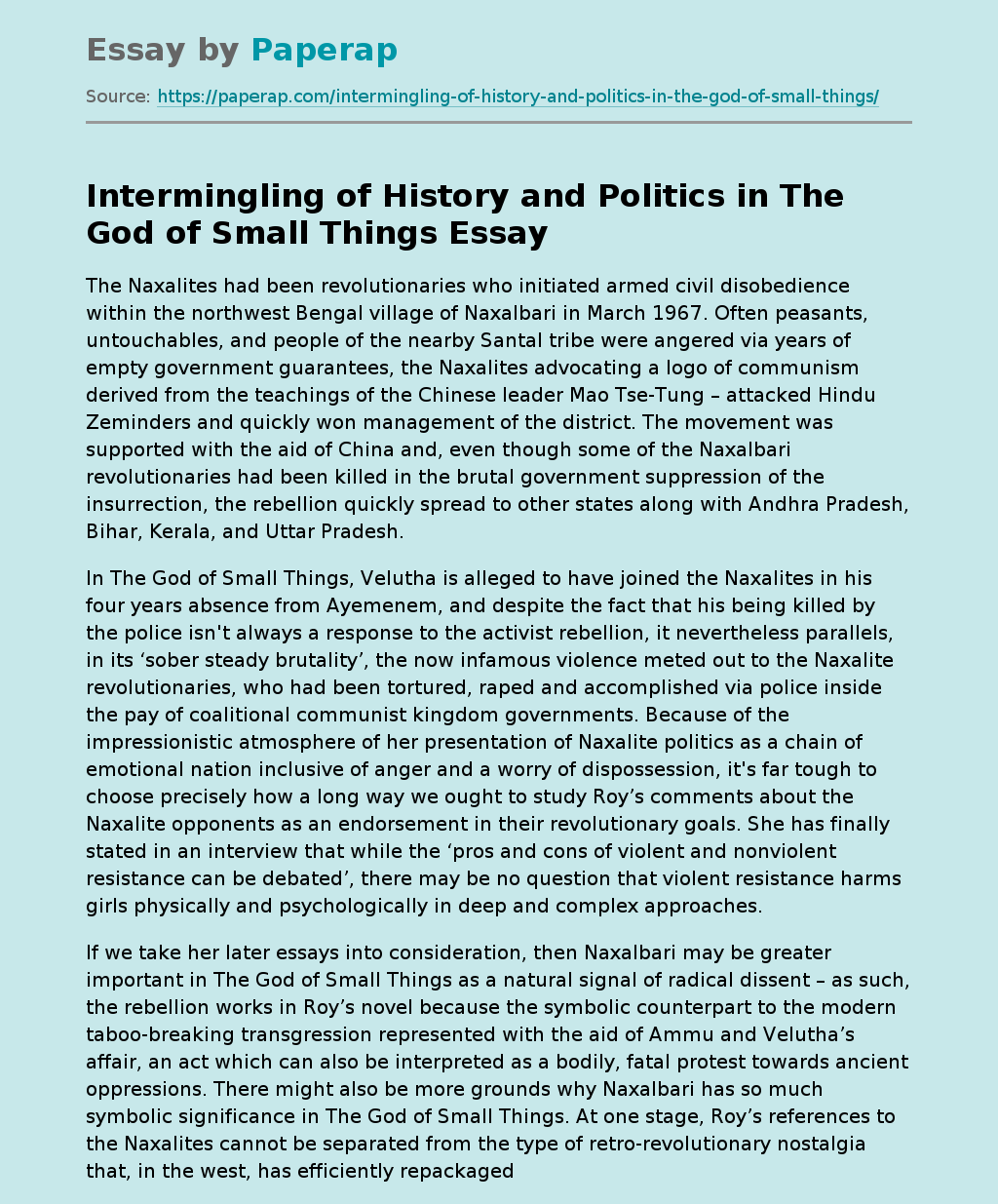Intermingling of History and Politics in The God of Small Things
The Naxalites had been revolutionaries who initiated armed civil disobedience within the northwest Bengal village of Naxalbari in March 1967. Often peasants, untouchables, and people of the nearby Santal tribe were angered via years of empty government guarantees, the Naxalites advocating a logo of communism derived from the teachings of the Chinese leader Mao Tse-Tung – attacked Hindu Zeminders and quickly won management of the district. The movement was supported with the aid of China and, even though some of the Naxalbari revolutionaries had been killed in the brutal government suppression of the insurrection, the rebellion quickly spread to other states along with Andhra Pradesh, Bihar, Kerala, and Uttar Pradesh.
In The God of Small Things, Velutha is alleged to have joined the Naxalites in his four years absence from Ayemenem, and despite the fact that his being killed by the police isn’t always a response to the activist rebellion, it nevertheless parallels, in its ‘sober steady brutality’, the now infamous violence meted out to the Naxalite revolutionaries, who had been tortured, raped and accomplished via police inside the pay of coalitional communist kingdom governments.
Because of the impressionistic atmosphere of her presentation of Naxalite politics as a chain of emotional nation inclusive of anger and a worry of dispossession, it’s far tough to choose precisely how a long way we ought to study Roy’s comments about the Naxalite opponents as an endorsement in their revolutionary goals. She has finally stated in an interview that while the ‘pros and cons of violent and nonviolent resistance can be debated’, there may be no question that violent resistance harms girls physically and psychologically in deep and complex approaches.
If we take her later essays into consideration, then Naxalbari may be greater important in The God of Small Things as a natural signal of radical dissent – as such, the rebellion works in Roy’s novel because the symbolic counterpart to the modern taboo-breaking transgression represented with the aid of Ammu and Velutha’s affair, an act which can also be interpreted as a bodily, fatal protest towards ancient oppressions. There might also be more grounds why Naxalbari has so much symbolic significance in The God of Small Things. At one stage, Roy’s references to the Naxalites cannot be separated from the type of retro-revolutionary nostalgia that, in the west, has efficiently repackaged Che Guevara as a style icon who became the photogenic Argentinean revolutionary and who took component in Fidel Castro’s communist coup in the Fifties in Cuba. The distinction, as the cultural critic John Hutnyk argues, is that for writers, artists and musicians in India and in the Indian diaspora, Naxalbari may additionally provide an opportunity to the insipid Bollywood way of life that represents them globally.
For Roy, progress and advancements in agriculture and hydroelectric plants like the Narmada dam ventures have confiscated India’s most defenseless marginalized groups in the name of advancement. In Roy’s view, the Western idea of improvement, when connected to India, uncovers a significant absence of creative ability, and by aimlessly following a formative way, the Indian state, which sought outside venture as a major aspect of its monetary advancement in the mid-1910s, has devastated its own nationals and end up entangled in degenerate management of worldwide multinationals, for example, the vitality of goliath Enron. The effect of outside speculation and India’s expanded financial development rate is obvious in The God of Small Things in the way the residential community of Ayemenem changes and moves toward becoming globalized between the two time plans of the novel; its tenants get themselves ready to profit working miserably in the inlet states, however, their new riches exists together with expanded destitution and sketchy imports, for example, tourism and satellite TV.
Without particular approaches to target destitution, contends the history specialist Sunil Khilnani, financial progression is probably going to build social imbalances in India in a few ways: broadening aberrations in social open doors honing the separation amongst country and urban India and expanding contrasts in riches between districts. A lot of Roy’s wirings since The God of Small Things has scrutinized the predominance of the story of neo-liberal free enterprise, and her help for bunches like the NBA can be viewed as an endeavor to secure its choices – political stories ‘that are not quite the same as the ones we are being mentally programmed to accept’. For Roy, India’s political alternatives are local: ‘Decentralized economics, decentralized control; handing some measure of power back to the people. What’s more, at last, her political expectations are established on India’s inborn protection from a solitary thought. Like her vision of the novel as a story that can’t be told in one way, India’s future depends, in her work, on its majority: “India’s redemption lies in the inherent anarchy and fractiousness of its people and its political formations. Corporatizing India is like trying to impose an iron grid on a heaving ocean, forcing it to behave. My guess is that India will not behave. It cannot. It’s too diverse, too grand, too feral, and eventually, I hope – too democratic to be lobotomized into believing in one single idea, which is, eventually, what corporate globalization really is: Life is Profit.”
Intermingling of History and Politics in The God of Small Things. (2021, Dec 11). Retrieved from https://paperap.com/intermingling-of-history-and-politics-in-the-god-of-small-things/

